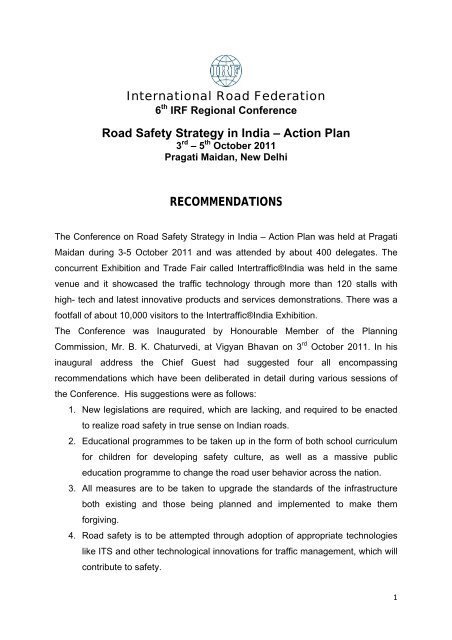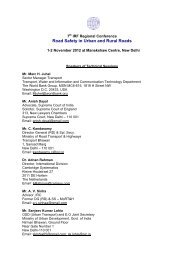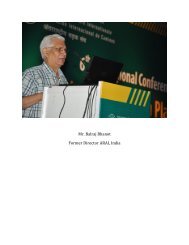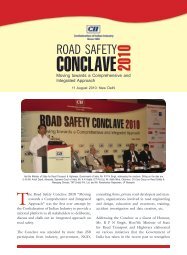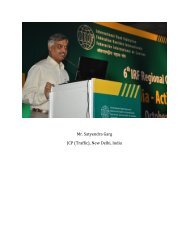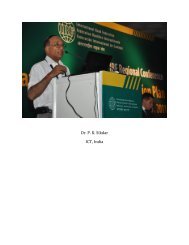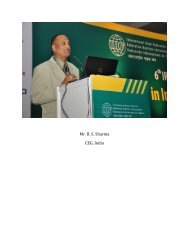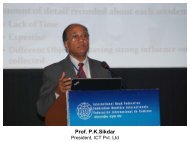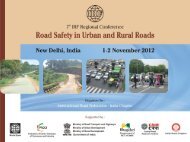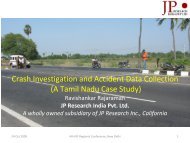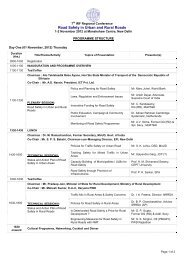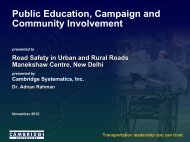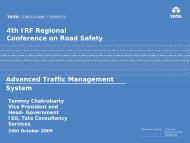International Road Federation Road Safety ... - IRF India chapter
International Road Federation Road Safety ... - IRF India chapter
International Road Federation Road Safety ... - IRF India chapter
Create successful ePaper yourself
Turn your PDF publications into a flip-book with our unique Google optimized e-Paper software.
<strong>International</strong> <strong>Road</strong> <strong>Federation</strong><br />
6 th <strong>IRF</strong> Regional Conference<br />
<strong>Road</strong> <strong>Safety</strong> Strategy in <strong>India</strong> – Action Plan<br />
3 rd – 5 th October 2011<br />
Pragati Maidan, New Delhi<br />
RECOMMENDATIONS<br />
The Conference on <strong>Road</strong> <strong>Safety</strong> Strategy in <strong>India</strong> – Action Plan was held at Pragati<br />
Maidan during 3-5 October 2011 and was attended by about 400 delegates. The<br />
concurrent Exhibition and Trade Fair called Intertraffic®<strong>India</strong> was held in the same<br />
venue and it showcased the traffic technology through more than 120 stalls with<br />
high- tech and latest innovative products and services demonstrations. There was a<br />
footfall of about 10,000 visitors to the Intertraffic®<strong>India</strong> Exhibition.<br />
The Conference was Inaugurated by Honourable Member of the Planning<br />
Commission, Mr. B. K. Chaturvedi, at Vigyan Bhavan on 3 rd October 2011. In his<br />
inaugural address the Chief Guest had suggested four all encompassing<br />
recommendations which have been deliberated in detail during various sessions of<br />
the Conference. His suggestions were as follows:<br />
1. New legislations are required, which are lacking, and required to be enacted<br />
to realize road safety in true sense on <strong>India</strong>n roads.<br />
2. Educational programmes to be taken up in the form of both school curriculum<br />
for children for developing safety culture, as well as a massive public<br />
education programme to change the road user behavior across the nation.<br />
3. All measures are to be taken to upgrade the standards of the infrastructure<br />
both existing and those being planned and implemented to make them<br />
forgiving.<br />
4. <strong>Road</strong> safety is to be attempted through adoption of appropriate technologies<br />
like ITS and other technological innovations for traffic management, which will<br />
contribute to safety.<br />
1
The theme of the Conference was selected with an aim to formulate the strategy and<br />
action plan for <strong>India</strong>, which will be able to assist the Government for drawing up the<br />
Action Plan for the UN Decade of Action for <strong>Road</strong> <strong>Safety</strong> 2011-2020. Thus, all the<br />
sub-themes selected were on the 5 pillars of <strong>Road</strong> <strong>Safety</strong> as have been suggested<br />
by the Decade of Action. The highly committed delegates have extensively<br />
deliberated on the sub-themes based on the high quality presentations made by the<br />
Experts. The theme-wise following recommendations were derived from the<br />
Conference proceedings.<br />
I - Building <strong>Road</strong> <strong>Safety</strong> Management Capacity<br />
(i)<br />
(ii)<br />
(iii)<br />
(iv)<br />
(v)<br />
(vi)<br />
Government’s initiative to form the National <strong>Road</strong> <strong>Safety</strong> & Traffic<br />
Management Board is to be speeded up for creation of the National and State<br />
Level Boards to implement road safety effectively and uniformly across the<br />
country.<br />
Sustainable funding arrangement is to be made for road safety by contribution<br />
from both Government as well as private sector (i.e. corporate world). A <strong>Road</strong><br />
<strong>Safety</strong> Fund (RSF) is to be created for effective delivery of projects take up on<br />
road safety.<br />
Technical capacity is to be enhanced in <strong>Road</strong> Authorities (both in number and<br />
skills) across the country to effectively deal with planning, design and<br />
implementation of road project with specific built-in objectives of road safety.<br />
All highway and traffic engineers are to be trained to develop safety<br />
mindedness and be equipped (trained to be skilled) to tackle various road<br />
safety problems. Requisite number of training institutes must be set up for this<br />
purpose, and existing Institutions like CRRI, NITHE and CTM are to be also<br />
utilized.<br />
<strong>Road</strong> Traffic Act (RTA) is to be enacted to define the responsibilities of all road<br />
users on road without discrimination; this is likely to make the road users to<br />
behave more responsibly. This will also change the vehicle insurance<br />
regulations making it more rational as in western world.<br />
Management of road safety involves total coordination of multiple stakeholder<br />
organizations, all of whom must be part of the safety objectives targeted (all<br />
must clearly and uniformly know what is required).<br />
2
II - Upgrading <strong>Safety</strong> in <strong>Road</strong> Infrastructure<br />
(i) Mandatory checks and audits in the form of <strong>Road</strong> <strong>Safety</strong> Audit (RSA)<br />
should be enforced at all stages of planning, design and implementation of<br />
road projects. The recommendations of RSA must be mandatorily<br />
complied, irrespective of cost implications.<br />
(ii) Update the existing standards and guidelines based on research and<br />
learning from the past experiences in a time-bound manner. All<br />
contradictions in these standards and guidelines should be eliminated.<br />
(iii) All designs must be forgiving and as per the best know-how and research<br />
results available from within the country as well as around the world. All<br />
the requirements of different types of vulnerable road users must be<br />
provided as per the prevailing standards without any compromise.<br />
(iv) There must be accountability for the <strong>Road</strong> Authorities / Agencies /<br />
Consultants involved in the design of the road and its associated<br />
infrastructures; and they must be made responsible for the risks left<br />
unattended in the design.<br />
(v) A well planned and designed road with evaluation of alternatives, is always<br />
more economical in cost and implementation time. Therefore, adequate<br />
and logical time shall be allotted for planning and design works to avoid all<br />
types of deficiencies in the detailing.<br />
(vi) In the PPP/DBFOT projects, accountability of the Concessionaire for road<br />
safety can be built into the Concession Agreement (CA) by indicating a<br />
measurable/quantified penalty for each accident taking place on the<br />
project highway; there has to be zero tolerance to achieve safety in real<br />
sense.<br />
(vii) All PPP projects must be given star rating every year based on the<br />
safety performance of the project road. Further, Concessionaire with better<br />
performance record should be given extra points in his subsequent bidding<br />
for projects based on star ratings.<br />
III - Enhancement of <strong>Safety</strong> in Vehicles<br />
(i) All vehicles must be uniformly equipped with all in-vehicle safety<br />
devices regardless of their costs. This must be enforced through a<br />
policy of the Government.<br />
3
(ii) The inspection and maintenance regime should be established (for<br />
ensuring road worthiness of each vehicle) by an enactment along with<br />
fully equipped testing centres (which may be privatized also). All the<br />
provisions of M.V. Act regarding the compliance to the safety standards<br />
(in all features of a vehicle) must be enforced completely without any<br />
relaxation for any type of vehicle.<br />
(iii) Non-motorised Vehicle Act is to be promulgated for controlling the<br />
fitness or road worthiness of these vehicles along with their usability in<br />
urban and non-urban roads.<br />
IV - Improvement in <strong>Road</strong> User Behaviour<br />
(i) The enforcement efforts assisted with appropriate technology (like speed<br />
camera, red-light camera, etc.) must be adopted for indiscriminate<br />
enforcement, to curb violations. This will automatically change the<br />
behavior, when they will find that the chances of being caught is the<br />
maximum, and therefore, violations will be avoided.<br />
(ii) All enforcement efforts should be effected by use of latest technologies,<br />
and it must be associated with vigorous awareness campaign and publicity<br />
about the enforcement in all forms of media.<br />
(iii) The education is to be carried out at different levels. Structured school<br />
curriculum to be adopted uniformly across the country to inculcate road<br />
safety culture in the children who are the future generations. In addition,<br />
intensive public education and awareness campaign should be done on<br />
continuous basis especially for speed limits, impaired driving, helmet, seatbelt<br />
and child restraint. These campaigns are to be taken up as social<br />
marketing, and often referred as viral campaign.<br />
(iv) Automated / technology based traffic management, even if it is stringent,<br />
has more acceptance from public, and it is going to make the rod users<br />
more rational in their use of road. It will have better chance to change the<br />
road user behavior.<br />
V – Emergency Services for improving <strong>Road</strong> <strong>Safety</strong><br />
4
(i) Awareness of the Supreme Court directives, that any accident victim<br />
who is taken to the hospital will be attended by the hospital authorities,<br />
no hospital can refuse to treat an accident victim, and the police will not<br />
question the person who brings the accident victim to hospital, are to<br />
be publicized through all types of media.<br />
(ii) Emergency vehicles must have preferred right of way on road by strict<br />
enforcement, and with exclusive access to hospitals’ emergency care<br />
as well as trauma centres. In special cases, helicopter services may<br />
also be used for saving lives.<br />
(iii) An extensive network of trauma care centres and hospitals with facility<br />
of trauma care must be established along all 70,000+ kms of National<br />
Highway and the State Highway network, which will create a 15-20 km<br />
grid for accessing hospitals.<br />
(iv) For delivering the emergency care services most effectively, there must<br />
be special courses in trauma care in medical colleges. All the driving<br />
license holders are to be trained for basic first-aid emergency care to<br />
help the accident victims.<br />
To realize the ultimate objective of safer roads, this mammoth campaign is to reach<br />
to every <strong>India</strong>n, and it is to be championed by someone from the highest level of<br />
political echelon, like Prime Minister or President of the country. The UN Decade of<br />
Action aims for safety in all categories of road, and therefore, the target should be to<br />
‘Build Safer <strong>Road</strong>s, Not More <strong>Road</strong>s’. Based on these recommendations, the next<br />
step will be to prepare a Detailed Action Plan, which shall be the onus of the various<br />
Government Departments & Ministries to pursue and deliver during the Decade of<br />
Action. The <strong>Road</strong> <strong>Safety</strong> Action Plan is to be formulated under following steps,<br />
• Identify measurable indicators under each of the 5 pillars along with the<br />
actions to be implemented<br />
• Create baseline data (as-is basis) for each of the 5 pillars<br />
• Set targets for next 10 years (with some intermediate target also)<br />
• Monitor the outcomes of the action plan at every 2-3 years<br />
5


